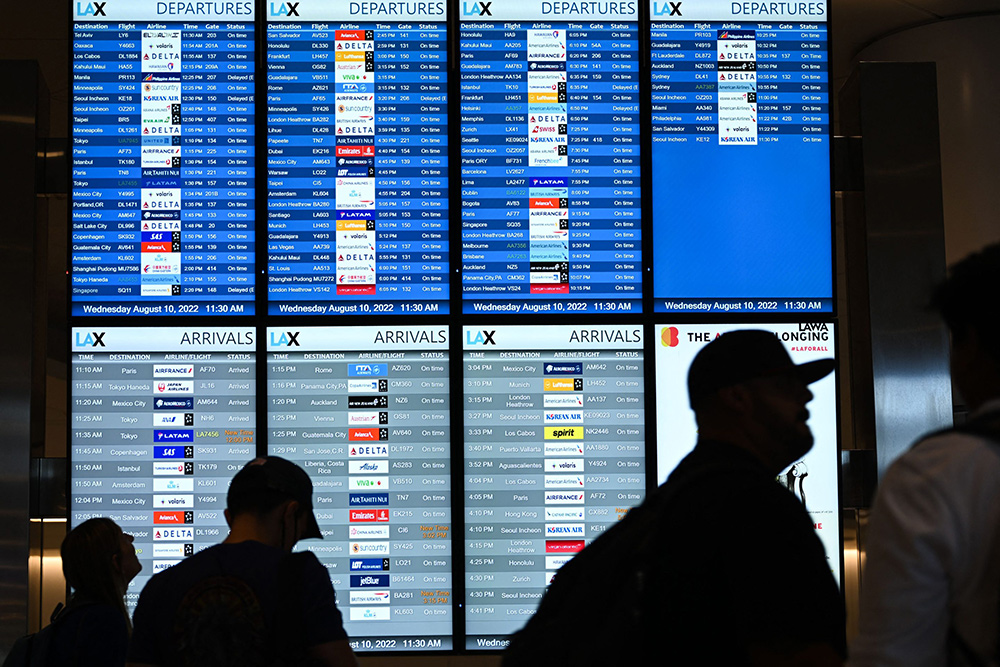
在新冠疫情爆發(fā)期間,航空旅行戛然而止,,客流量將至冰點(diǎn),,彼時情形在進(jìn)入噴氣機(jī)時代以來前所未見。飛機(jī)密密麻麻地停放在荒原里,。機(jī)場空無一人,,好似被遺忘的鬼城,不復(fù)往日作為交通和商業(yè)樞紐的熱鬧,。當(dāng)時人們十分擔(dān)心,,美國經(jīng)濟(jì)里的這個行業(yè)可能會崩盤。那是航空業(yè)的至暗時期,。
今天的航空業(yè)重燃生機(jī),。每天,有200萬美國人收拾好行李,,過完安檢,,登上飛機(jī)。美國人攜家人度假,、參加婚禮,,或者終于實(shí)現(xiàn)了與親朋好友一拖再拖的重聚。
沒有人會想到,,美國航空業(yè)的客運(yùn)量會在幾個月內(nèi)從20世紀(jì)50年代的水平飆升至接近2019年的水平,。這種恢復(fù)速度比經(jīng)濟(jì)學(xué)家、分析師和行業(yè)觀察人士預(yù)測的要快得多,。
在如此短的時間內(nèi)重啟整個行業(yè)是前所未有的壯舉,,而如果沒有“薪資支持計(jì)劃”(Payroll Support Program),這是不可能實(shí)現(xiàn)的,。新冠疫情期間,,美國航空公司加起來每個月要燒掉100億美元至120億美元,而且看不到盡頭,,那時的“薪資支持計(jì)劃”是航空業(yè)的救命稻草,。
得益于該項(xiàng)目的實(shí)施,美國的航空公司能夠繼續(xù)經(jīng)營,,免于破產(chǎn),。運(yùn)營商可以讓成千上萬的員工保住工作、接受培訓(xùn),、獲得執(zhí)照,、做好上崗準(zhǔn)備。眾議院和參議院的民主黨和共和黨都支持“薪資支持計(jì)劃”,代表空乘,、飛行員和機(jī)械師的勞工領(lǐng)袖也支持“薪資支持計(jì)劃”,。根據(jù)法律規(guī)定,“薪資支持計(jì)劃”的資金只能用于支付員工工資,,而且運(yùn)營商已經(jīng)償還了政府貸款,。沒有“薪資支持計(jì)劃”,航空業(yè)可能已經(jīng)不復(fù)存在,。今天,,美國的航線還在繼續(xù)飛,人們能飛機(jī)出行,,都要感謝“薪資支持計(jì)劃”,。
這種突然的復(fù)蘇也帶來了挑戰(zhàn)。與其他行業(yè)一樣,,航空公司也需要努力適應(yīng)發(fā)生了巨大變化的員工隊(duì)伍,,需要認(rèn)識到新冠疫情爆發(fā)前的人員配備模式已經(jīng)無法勝任現(xiàn)狀。因?yàn)樾鹿诜窝锥埣俚膯T工越來越多,,能夠加班的員工也越來越少,,航空公司需要更多隨時待命的后備員工。
航空公司的招聘速度很快,。他們投資于飛行學(xué)院,同時大力開展招聘,。上周,,美國交通統(tǒng)計(jì)局(Bureau of Transportation Statistics)宣布,美國航空公司的就業(yè)人數(shù)已經(jīng)達(dá)到歷史最高水平,。截至2022年6月,,美國航空運(yùn)輸協(xié)會(A4A)的客運(yùn)航空公司每1000個區(qū)塊小時配備的飛行員數(shù)量比2019年6月增加了10%。
另一邊,,美國聯(lián)邦航空管理局(Federal Aviation Authority)也啟動了招聘活動,,確保有足夠的空中交通管制員接受培訓(xùn),上塔臺工作,。然而,,這個過程沒有那么簡單?!爱?dāng)聯(lián)邦航空局面臨空管員的人員配備問題時,,不是說把經(jīng)過完全認(rèn)證的專業(yè)管制員從一個塔臺安排到另一個塔臺那么簡單?!泵绹鴩铱罩薪煌ü苤茊T協(xié)會(National Air Traffic Controllers Association)的主席兼首席執(zhí)行官里奇·桑塔最近表示,,“在一個場地獲得完全認(rèn)證的空管人員轉(zhuǎn)崗時,仍然必須接受關(guān)于新場地地圖、飛機(jī)頻次,、空域,、程序和交通方面的培訓(xùn),而且無法保證這個過程需要多長時間,,也無法保證他們能否成功,。”
航空公司一直與美國聯(lián)邦航空管理局保持合作,,共同應(yīng)對包括惡劣天氣在內(nèi)的運(yùn)營挑戰(zhàn),,以便及時調(diào)整行程,航空公司能及時與旅客溝通,。
航空公司深知與客戶溝通的重要性,,這也是為什么它們加快加大投資,對移動應(yīng)用程序等技術(shù)進(jìn)行升級,。旅客越來越依賴高科技來辦理乘機(jī)手續(xù),、查閱航司運(yùn)營動態(tài)、追蹤行李和自動改簽,。
美國交通部(Department of Transportation)的部長皮特·布蒂吉格近期表示,,航空公司需要按照“現(xiàn)實(shí)的”時間表運(yùn)行,這正是我們正在做的,。航司在不斷進(jìn)行運(yùn)營評估,。去年春季,美國航空公司主動調(diào)整了時間表,,將夏季運(yùn)力減少了16%,,以適應(yīng)現(xiàn)有的員工配備情況。
航空公司也調(diào)整了出行政策以增加靈活性,,例如取消改簽費(fèi)或免除旅行積分的使用有效期,。自新冠疫情爆發(fā)以來,美國航空公司已經(jīng)支付了210億美元的現(xiàn)金退款,,美國交通部收到的退款投訴一直在穩(wěn)步下降,。
雖然我們知道建立新常態(tài)需要時間,但美國的航空公司正在努力恢復(fù)服務(wù),,改善運(yùn)營,,調(diào)整我們的商業(yè)模式,以更好地為旅客服務(wù),。
從購票到落地的每一個環(huán)節(jié),,航空公司始終致力于為客戶提供最高水平的服務(wù)。簡而言之,,我們希望旅行者擁有安全,、無縫,、正面的旅行體驗(yàn)——我們每天都在朝著這個目標(biāo)努力。(財(cái)富中文網(wǎng))
尼古拉斯·E·卡利奧(Nicholas E. Calio)是美國航空運(yùn)輸協(xié)會(Airlines for America,,簡稱為A4A)的首席執(zhí)行官,。
Fortune.com發(fā)表的評論文章僅代表作者本人觀點(diǎn),不代表《財(cái)富》雜志的立場和觀點(diǎn),。
譯者:Agatha
在新冠疫情爆發(fā)期間,,航空旅行戛然而止,客流量將至冰點(diǎn),,彼時情形在進(jìn)入噴氣機(jī)時代以來前所未見,。飛機(jī)密密麻麻地停放在荒原里。機(jī)場空無一人,,好似被遺忘的鬼城,,不復(fù)往日作為交通和商業(yè)樞紐的熱鬧。當(dāng)時人們十分擔(dān)心,,美國經(jīng)濟(jì)里的這個行業(yè)可能會崩盤,。那是航空業(yè)的至暗時期。
今天的航空業(yè)重燃生機(jī),。每天,,有200萬美國人收拾好行李,過完安檢,,登上飛機(jī),。美國人攜家人度假、參加婚禮,,或者終于實(shí)現(xiàn)了與親朋好友一拖再拖的重聚,。
沒有人會想到,美國航空業(yè)的客運(yùn)量會在幾個月內(nèi)從20世紀(jì)50年代的水平飆升至接近2019年的水平,。這種恢復(fù)速度比經(jīng)濟(jì)學(xué)家、分析師和行業(yè)觀察人士預(yù)測的要快得多,。
在如此短的時間內(nèi)重啟整個行業(yè)是前所未有的壯舉,,而如果沒有“薪資支持計(jì)劃”(Payroll Support Program),這是不可能實(shí)現(xiàn)的,。新冠疫情期間,,美國航空公司加起來每個月要燒掉100億美元至120億美元,而且看不到盡頭,,那時的“薪資支持計(jì)劃”是航空業(yè)的救命稻草,。
得益于該項(xiàng)目的實(shí)施,美國的航空公司能夠繼續(xù)經(jīng)營,,免于破產(chǎn),。運(yùn)營商可以讓成千上萬的員工保住工作,、接受培訓(xùn)、獲得執(zhí)照,、做好上崗準(zhǔn)備,。眾議院和參議院的民主黨和共和黨都支持“薪資支持計(jì)劃”,代表空乘,、飛行員和機(jī)械師的勞工領(lǐng)袖也支持“薪資支持計(jì)劃”,。根據(jù)法律規(guī)定,“薪資支持計(jì)劃”的資金只能用于支付員工工資,,而且運(yùn)營商已經(jīng)償還了政府貸款,。沒有“薪資支持計(jì)劃”,航空業(yè)可能已經(jīng)不復(fù)存在,。今天,,美國的航線還在繼續(xù)飛,人們能飛機(jī)出行,,都要感謝“薪資支持計(jì)劃”,。
這種突然的復(fù)蘇也帶來了挑戰(zhàn)。與其他行業(yè)一樣,,航空公司也需要努力適應(yīng)發(fā)生了巨大變化的員工隊(duì)伍,,需要認(rèn)識到新冠疫情爆發(fā)前的人員配備模式已經(jīng)無法勝任現(xiàn)狀。因?yàn)樾鹿诜窝锥埣俚膯T工越來越多,,能夠加班的員工也越來越少,,航空公司需要更多隨時待命的后備員工。
航空公司的招聘速度很快,。他們投資于飛行學(xué)院,,同時大力開展招聘。上周,,美國交通統(tǒng)計(jì)局(Bureau of Transportation Statistics)宣布,,美國航空公司的就業(yè)人數(shù)已經(jīng)達(dá)到歷史最高水平。截至2022年6月,,美國航空運(yùn)輸協(xié)會(A4A)的客運(yùn)航空公司每1000個區(qū)塊小時配備的飛行員數(shù)量比2019年6月增加了10%,。
另一邊,美國聯(lián)邦航空管理局(Federal Aviation Authority)也啟動了招聘活動,,確保有足夠的空中交通管制員接受培訓(xùn),,上塔臺工作。然而,,這個過程沒有那么簡單,。“當(dāng)聯(lián)邦航空局面臨空管員的人員配備問題時,,不是說把經(jīng)過完全認(rèn)證的專業(yè)管制員從一個塔臺安排到另一個塔臺那么簡單,?!泵绹鴩铱罩薪煌ü苤茊T協(xié)會(National Air Traffic Controllers Association)的主席兼首席執(zhí)行官里奇·桑塔最近表示,“在一個場地獲得完全認(rèn)證的空管人員轉(zhuǎn)崗時,,仍然必須接受關(guān)于新場地地圖,、飛機(jī)頻次、空域,、程序和交通方面的培訓(xùn),,而且無法保證這個過程需要多長時間,也無法保證他們能否成功,?!?/p>
航空公司一直與美國聯(lián)邦航空管理局保持合作,共同應(yīng)對包括惡劣天氣在內(nèi)的運(yùn)營挑戰(zhàn),,以便及時調(diào)整行程,,航空公司能及時與旅客溝通。
航空公司深知與客戶溝通的重要性,,這也是為什么它們加快加大投資,,對移動應(yīng)用程序等技術(shù)進(jìn)行升級。旅客越來越依賴高科技來辦理乘機(jī)手續(xù),、查閱航司運(yùn)營動態(tài),、追蹤行李和自動改簽。
美國交通部(Department of Transportation)的部長皮特·布蒂吉格近期表示,,航空公司需要按照“現(xiàn)實(shí)的”時間表運(yùn)行,,這正是我們正在做的。航司在不斷進(jìn)行運(yùn)營評估,。去年春季,,美國航空公司主動調(diào)整了時間表,將夏季運(yùn)力減少了16%,,以適應(yīng)現(xiàn)有的員工配備情況,。
航空公司也調(diào)整了出行政策以增加靈活性,例如取消改簽費(fèi)或免除旅行積分的使用有效期,。自新冠疫情爆發(fā)以來,,美國航空公司已經(jīng)支付了210億美元的現(xiàn)金退款,美國交通部收到的退款投訴一直在穩(wěn)步下降,。
雖然我們知道建立新常態(tài)需要時間,但美國的航空公司正在努力恢復(fù)服務(wù),,改善運(yùn)營,,調(diào)整我們的商業(yè)模式,以更好地為旅客服務(wù),。
從購票到落地的每一個環(huán)節(jié),,航空公司始終致力于為客戶提供最高水平的服務(wù),。簡而言之,我們希望旅行者擁有安全,、無縫,、正面的旅行體驗(yàn)——我們每天都在朝著這個目標(biāo)努力。(財(cái)富中文網(wǎng))
尼古拉斯·E·卡利奧(Nicholas E. Calio)是美國航空運(yùn)輸協(xié)會(Airlines for America,,簡稱為A4A)的首席執(zhí)行官,。
Fortune.com發(fā)表的評論文章僅代表作者本人觀點(diǎn),不代表《財(cái)富》雜志的立場和觀點(diǎn),。
譯者:Agatha
During the pandemic, air travel came to a screeching halt, plummeting to levels not seen since the dawn of the jet age. Airplanes were parked wing to wing in the desert. Airports were left empty, like forgotten ghost towns, not resembling hubs of transportation and commerce. There was widespread fear that this sector of the U.S. economy could collapse. These were dire times for the airline industry.
Today, airline travel is booming. Every day, 2 million people pack their bags, clear security, and board airplanes in the U.S. Americans are taking family vacations, attending weddings, and heading to long-postponed reunions with their loved ones.
Nobody could have anticipated that the U.S. airline industry would see passenger volumes skyrocket from 1950s levels to close to 2019 levels in a matter of months. This recovery has been much faster than economists, analysts, and industry observers had predicted.
Relaunching an entire industry in such a short period of time is an unprecedented feat–and it would not have been possible without the Payroll Support Program (PSP). PSP was a lifeline for the industry at a time when U.S. airlines were collectively burning $10-12 billion each month, with no end in sight.
The program ensured U.S. airlines were able to stay in business and avoid bankruptcy. Carriers were able to keep hundreds of thousands of employees on the job, trained, licensed, and ready to go. Democrats and Republicans–in the House and Senate–supported PSP, as did labor leaders representing flight attendants, pilots, and mechanics. The PSP funds went only to the paychecks of employees, as stipulated by law, and carriers have paid back the government loans. Without PSP, we may not have an airline industry in this country at all. Today, U.S. airlines are flying and people are traveling thanks to PSP.
The sudden resurgence has come with challenges. Like other industries, airlines are navigating a dramatically changed workforce and learning that pre-pandemic staffing models simply no longer work. There are more employee absences due to COVID-19 and fewer employees are able to work overtime. Therefore, airlines need more on-call reserve employees.
Airlines are hiring at a rapid pace. They are investing in flight academies and have launched employment campaigns. Last week, the Bureau of Transportation Statistics announced that U.S. airline employment has reached an all-time high. As of June 2022, A4A passenger carriers were staffed with 10% more pilots per 1,000 block hours than they were in June 2019.
For their part, the Federal Aviation Authority (FAA) has launched a hiring campaign to help ensure an adequate number of air traffic controllers are trained and in towers. However, it’s not a simple process. “As we face controller staffing challenges in the FAA, it’s not as simple as moving fully certified professional controllers from one facility to another,”?National Air Traffic Controllers Association President and CEO Rich Santa recently said. “Controllers who are fully certified in one facility must still train on the maps, frequencies, airspace, procedures, and traffic at their new facility and there is no guarantee of how long it will take or that they will be successful.”
Airlines constantly collaborate with the FAA to address shared operational challenges, including inclement weather, so schedules can be adjusted, and carriers can communicate with travelers.
Our airlines understand the importance of communicating with customers, which is why they have expedited significant investments in upgrades to technologies, including mobile apps. And travelers are increasingly relying on technology for check-in, operational updates, baggage tracking, and automatic rebooking.
Department of Transportation Secretary Pete Buttigieg recently said that airlines need to operate “realistic” schedules, and that is exactly what we are doing. Carriers are constantly evaluating their operations. Last spring, U.S. airlines proactively adjusted their schedules and reduced summer capacity by 16% to accommodate staffing realities.
Airlines have also adjusted travel policies to increase flexibility such as eliminating change fees or waiving expiration dates on travel credits. U.S. carriers have issued $21 billion in cash refunds since the onset of the pandemic, and refund complaints to the Department of Transportation (DOT) have been steadily declining.
While we recognize that it will take time to establish a new normal, U.S. airlines are committed to restoring service, improving operations, and adjusting our business models to better serve the traveling public.
Airlines always strive to provide the highest levels of customer service from ticket purchase to touchdown. Simply put, we want travelers to have a safe, seamless, and positive travel experience–and we won’t stop working toward that goal every day.
Nicholas E. Calio is the president and CEO of Airlines for America (A4A).
The opinions expressed in Fortune.com commentary pieces are solely the views of their authors and do not reflect the opinions and beliefs of Fortune.






